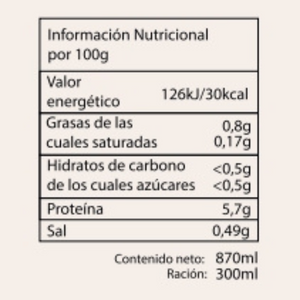Intermittent Fasting: What it is, its history, benefits, and types
Intermittent fasting is a practice that has gained popularity in recent years for its health benefits, especially in terms of weight loss, improved metabolism, and prevention of chronic diseases. However, what many don't know is that fasting is not a recent fad. This practice has been used by various cultures throughout history, for both religious and cultural reasons, as well as for health reasons.
What is intermittent fasting?
Intermittent fasting is an eating pattern based on alternating periods of eating and fasting. Unlike traditional diets, which focus on what you eat, intermittent fasting focuses on when you eat. During periods of fasting, the body has the opportunity to draw on its energy reserves, primarily fat, which facilitates weight loss and improved metabolic health.
There are different ways to practice intermittent fasting, which vary in duration and frequency of fasting periods . However, they all share the same premise: limiting the eating window to certain times of the day or even certain days of the week.
Fasting is nothing new; it has been an integral part of various religions and cultures around the world since ancient times. It's Lent for Christians, Ramadan for Islam, and Ekadachi for Hinduism. Furthermore, in ancient cultures such as the Greeks and Romans, fasting was recommended as a means to improve physical and mental health. Hippocrates, the "father of medicine," advocated it as a way to heal the body.
However, nowadays, we have access to food at all hours, at any time, so we eat much more than we should . Now, it's even frowned upon if we go more than four hours without eating. You've probably heard of the five-a-day approach or the never-skipping-a-meal approach. What evolutionary logic does that make? None. These guidelines only distance us from our intuition and disrupt our hunger and satiety systems.
Furthermore, eating constantly causes us to lose our ability to mobilize our energy reserves and makes us slaves to food. If we don't use our reserves, we won't be able to lose weight. Furthermore, if we're constantly eating and digesting, we're preventing our body from dedicating energy to other functions such as regeneration or detoxification.
Not only does evolution support intermittent fasting, but there are also a growing number of scientific studies that support the benefits of intermittent fasting . We've provided references below for further research on the topic.
What is intermittent fasting and what does it consist of?
It consists of NOT EATING or eating VERY LITTLE for a few hours a day or a certain period.
What's the best fasting schedule? There are several types of intermittent fasting . Here we explain the different ways to do intermittent fasting.
- NIGHT FAST : 12 hours. Allow 12 hours of digestive rest at night. Some people consider this a fast, however, it should be the minimum amount of time any healthy person can go without eating.
- 16/8 Fasting : This consists of eating within an 8-hour window and fasting within a 16-hour window. This means: Stop eating at 4:00 PM and have breakfast at 8:00 AM, or have dinner at 9:00 PM and lunch at 1:00 PM.
- 24-hour fasts: There are different approaches: OMAD (One Meal a Day), which means eating only once a day. Some people do it for a period of time, and others even make it a lifestyle. Others practice Eat Stop Eat, which involves incorporating one or two 24-hour fasts a week, without them being consecutive.
- 72-hour fast : This is a deep, therapeutic fast, much more advanced, and you must be prepared for it. It seeks to activate pathways such as AMPK (gluconeogenesis) and increase a series of processes that activate autophagy and cellular regeneration. It is usually done once or twice a year, although some people do it monthly.
- Semi-fasting or FMD (Fasting Mimicking Diet) is a diet created by Valter Longo that simulates fasting. FMD proposes eating very little (about 700 calories/day) for 4-5 days.
-
5:2 fasting involves eating normally for five days of the week and significantly reducing caloric intake (around 500-600 calories) on the other two days. This approach allows for greater flexibility on non-restrictive days.
-
Alternate Day Fasting: This approach involves alternating between days of normal eating and days of complete fasting or very low intakes. Although it's more difficult to follow than other methods, it has been shown to be effective for weight loss and improving metabolic health.
What are the benefits of intermittent fasting ?
1. Autophagy: Cellular Cleanup
One of the benefits of intermittent fasting is the stimulation of a biological process known as autophagy. This process allows cells to eliminate damaged or dysfunctional components, recycling their useful parts and disposing of what is unnecessary. Autophagy is especially activated during periods of prolonged fasting, as the body lacks an external source of nutrients and therefore begins to rely on internal resources to sustain itself.
This "cellular cleanup" process may help reduce the accumulation of toxins and waste products in the body, which could protect against neurodegenerative diseases and promote longevity.
2. Improvement of the lipid profile
Intermittent fasting has also been shown to have a positive impact on the body's lipid profile, which includes the concentration of cholesterol, triglycerides, and other fats in the blood. Several studies have found that intermittent fasting can reduce LDL ("bad") cholesterol levels and increase HDL ("good") cholesterol, contributing to improved cardiovascular health. It can also lower triglycerides, which are another risk factor for heart disease.
3. Improved insulin resistance
Insulin resistance is a key factor in the development of type 2 diabetes, and intermittent fasting has been shown to be an effective tool in combating it. By reducing the amount of time the body is exposed to insulin spikes, intermittent fasting can improve insulin sensitivity. This means the body's cells become more efficient at utilizing insulin, which in turn helps maintain stable blood glucose levels and reduce the risk of diabetes.
4. Increased metabolic flexibility
One of the most interesting aspects of intermittent fasting is how it helps improve metabolic flexibility—the body's ability to efficiently switch between burning carbohydrates and fat as an energy source. On conventional diets, the body tends to rely heavily on carbohydrates, which limits its ability to effectively burn fat. During periods of fasting, the body is forced to tap into its fat stores, which can improve fat burning and facilitate weight loss.
5. Neural plasticity
Another notable benefit of intermittent fasting is its positive impact on neuronal plasticity. Neuroplasticity is the brain's ability to adapt, reorganize, and form new synaptic connections in response to external or internal stimuli. Animal studies have shown that intermittent fasting can increase the production of neurotrophic factors, such as brain-derived neurotrophic factor (BDNF), which promotes the growth of new neurons and improves cognitive function.
This process could have important implications for the prevention of neurodegenerative diseases such as Alzheimer's and Parkinson's, as well as improving memory and learning ability. However, much remains to be studied.
6. Improves the immune system
Intermittent fasting can also benefit the immune system. During periods of fasting, the body enters a regenerative state in which immune cells, especially damaged or old ones, are eliminated and replaced with new, more efficient cells. This improves the body's ability to defend itself against infections and diseases.
Additionally, fasting reduces levels of chronic inflammation in the body, which is one of the underlying causes of many modern diseases. The reduction in inflammation, along with the renewal of immune cells, helps strengthen the immune system.
And now you may ask yourself, How do I start FASTING ?
The first thing would be to start by spacing dinner and lunch 12 hours apart. This is a basic health issue, but many people still haven't incorporated it into their habits. Once we feel good about our nighttime digestive rest, we recommend extending the fasting window to 16/8.
From there, listen to your body and don't eat when you're not hungry. In fact, fasting is NOT about starving, but rather about reconciling with the sensations of hunger and satiety. Eat when you're hungry.
Follow these steps to get started fasting .
- Before embarking on a fast, improve your diet by eliminating processed foods and eating quality foods. Generally, following a low-carb diet before fasting increases satiety and makes the fast more bearable.
- More isn't better. Keep in mind that fasting works through hormesis (what doesn't kill you makes you stronger).
- Start slowly, leaving a 12-hour gap between dinner and breakfast at first, and gradually increase your fasting window as you feel comfortable.
- Alternate days where your goal is to have bone broth for dinner, because it's ideal for preparing yourself to lengthen the fasting window until you reach the 16/8 intermittent fasting, which is the most common.
- Try different schedules and fasts, listen to your body, and do what feels right for you.
- When you feel strong enough, you can continue a little longer until you reach 24 hours. Extended fasts should be done occasionally and only once you're adapted.
- Remember, the most important thing is to stay hydrated during the fast. The big question: can you drink coffee during fasting or intermittent fasting ? The answer is yes, but ONLY coffee (without milk) and in small quantities, although it's always best to drink water or herbal teas with water. During prolonged fasts, it's permissible to drink bone broth , kombucha, sparkling water, and seawater to stay hydrated and mineralized.
- Breaking your fast with bone broth is the best way to remineralize, protect, and prepare yourself for other foods.
Does bone broth break a fast?
Technically, it does break the fast because it contains calories (mainly protein and some minerals). However, it's recommended for prolonged fasts and, of course, doesn't break the fast in the same way as a coffee with milk or a bowl of cereal:
- A cup of Cooldo bone broth provides 30 kcal
- It has collagen and amino acids that minimally activate insulin, but not abruptly.
- It keeps the body in a state of low glycemic load (without sugar or insulin spikes).
So why is bone broth recommended for fasting?
It is used as a “modified” fast for several reasons:
-
Reduces hunger and anxiety , making it easier to go 14–16 hours without solid food.
-
Avoid dizziness or energy drops in people who are new to fasting.
-
It provides electrolytes and minerals , helping to maintain hydration and mineral balance, which is key during prolonged fasts.
-
Protects the intestinal mucosa and prepares digestion when you break the fast.
-
It's a transition tool: many people start with broth and eventually move on to fasting on just water/tea/coffee.
Is fasting contraindicated?
Not everyone can fast, and certainly not under all circumstances. If you're experiencing a lot of stress, fasting may not be ideal, as it will add additional stress.
We do not recommend fasting for:
- People who have or have had a bad relationship with food (bulimia, anorexia, binge eating, etc.) as it can make the situation worse.
- Pregnant or breastfeeding women. During these stages, it is important to ensure nutrients for the baby, and fasting, if not properly planned, could prevent the mother's diet from meeting the nutritional needs of both.
- Patients with nutritional deficiencies.
- Athletes who need a lot of energy would have to concentrate an excessive amount of food in a few meals if they fast, which could cause them discomfort.
- Ectomorphs (thin with little fat and little muscle) who are trying to gain muscle mass and are in the bulking phase.
Do you want to get started with intermittent fasting?
At Cooldo, we've developed the 7-, 14-, and 21-day Fasting Starter Plan to give you the guidelines you need to follow. We encourage you to try it if it's a good time in your life to start!
LITERATURE
- New England Journal of Medicine, 381(26), 2541–2551. https://doi.org/10.1056/NEJMra1905136
- New England Journal of Medicine, 387(25), 2256–2267. https://doi.org/10.1056/NEJMoa220837
- JAMA Internal Medicine, 182(7), 744–753. https://doi.org/10.1001/jamainternmed.2022.1335
- JAMA Internal Medicine, 180(11), 1491–1499. https://doi.org/10.1001/jamainternmed.2020.4153
- JAMA Network Open, 6(7), e232345. https://doi.org/10.1001/jamanetworkopen.2023.2345
- BMJ, 380, e076704. https://doi.org/10.1136/bmj-2024-076704
- EClinicalMedicine, 57, 101833. https://doi.org/10.1016/j.eclinm.2023.101833
- Science Translational Medicine, 9(377), eaai8700. https://doi.org/10.1126/scitranslmed.aai8700
- Cell Metabolism, 19(2), 181–192. https://doi.org/10.1016/j.cmet.2013.12.008
- PLoS ONE, 15(1), e0245029. https://doi.org/10.1371/journal.pone.0245029










